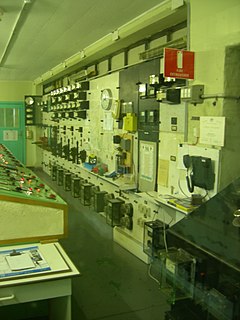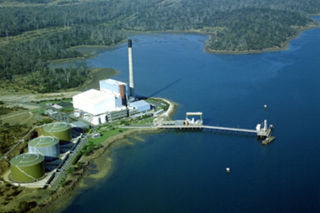Related Research Articles

The Lake Margaret Power Stations comprise two hydroelectric power stations located in Western Tasmania, Australia. The power stations are part of the King – Yolande Power Scheme and are owned and operated by Hydro Tasmania. Officially the Upper Lake Margaret Power Station, a conventional hydroelectric power station, and the Lower Lake Margaret Power Station, a mini-hydroelectric power station, the stations are generally collectively referred to in the singular format as the Lake Margaret Power Station. The stations are located approximately 2.5 kilometres (1.6 mi) apart.
Waddamana Hydro-Electric power station was the first hydro-electric power plant ever operated by the Tasmanian Hydro-Electric Department, opened in 1916.

Lostock Dam is a minor rockfill and clay core embankment dam with a concrete lined, flip bucket spillway across the Paterson River upstream of the village of East Gresford in the Hunter region of New South Wales, Australia. The dam's purpose includes flood mitigation, irrigation, water supply and conservation. Mini hydro-power facilities were retrofitted in 2010. The impounded reservoir is also called Lostock Dam.
The Shoalhaven Scheme is a dual-purpose water supply and Pumped-storage Hydroelectricity scheme located on the South Coast region of New South Wales, Australia.

The Bell Bay Power Station was a power station located in Bell Bay, on the Tamar River, Tasmania, Australia, adjacent to the Tamar Valley Power Station, with which it was often confused. It was commissioned between 1971 and 1974 as an oil fired thermal power station, and was converted to natural gas in 2003, after the commissioning of the Tasmanian Gas Pipeline, a submarine gas pipeline which transports natural gas from Longford, Victoria, under Bass Strait, to Bell Bay, Tasmania. As the power station's primary role was to provide system security in the event of drought for Tasmania's predominantly hydro-electric based generation system it only was rarely called on to operate, resulting in intervals of five to eight years between periods of significant use. After the commissioning of Basslink in 2006, the power station was decommissioned in 2009.

The Butlers Gorge Power Station is a conventional hydroelectric power station located in the Central Highlands region of Tasmania, Australia.

The Catagunya Power Station is a run-of-the-river hydroelectric power station located in the Central Highlands region of Tasmania, Australia. The power station is situated on the Lower River Derwent catchment and is owned and operated by Hydro Tasmania.

The Liapootah Power Station is a run-of-the-river hydroelectric power station located in the Central Highlands region of Tasmania, Australia. The power station is situated on the Lower River Derwent catchment and is owned and operated by Hydro Tasmania.

The Fisher Power Station is a conventional hydroelectric power station located in north-western Tasmania, Australia.

The Gordon Power Station is the largest conventional hydroelectric power station in Tasmania, Australia; located in the South West region of the state. The power station is situated on Gordon River. Water from Lake Gordon descends 183 metres (600 ft) underground past the Gordon Dam and into the power station.

The Trevallyn Power Station is a run-of-the-river hydroelectric power station located in the northern Midlands region of Tasmania, Australia. The power station is situated on the Great Lake and South Esk catchment and is owned and operated by Hydro Tasmania.

Run-of-river hydroelectricity (ROR) or run-of-the-river hydroelectricity is a type of hydroelectric generation plant whereby little or no water storage is provided. Run-of-the-river power plants may have no water storage at all or a limited amount of storage, in which case the storage reservoir is referred to as pondage. A plant without pondage is subject to seasonal river flows, thus the plant will operate as an intermittent energy source. Conventional hydro uses reservoirs, which regulate water for flood control and dispatchable electrical power.
Canada is the world's second largest producer of hydroelectricity after China. In 2014, Canada consumed the equivalent of 85.7 megatonnes worth of oil of hydroelectricity, 9.8% of worldwide hydroelectric consumption. Furthermore, hydroelectricity accounted for 25.7% of Canada's total energy consumption. It is the third-most consumed energy in Canada behind oil and natural gas.
The Shamkir Hydro Power Plant is one of Azerbaijan's largest hydro power plants having an installed electric capacity of 380 megawatts (510,000 hp). It is located on Shamkir reservoir in Shamkir Rayon of Azerbaijan, and is owned by Azerenerji.
The Nkhula B Hydroelectric Power Station, also Nkula B Hydroelectric Power Station is a hydroelectric power plant on the Shire River in Malawi. It has a power generating capacity of 100 megawatts (130,000 hp).

The Parangana Power Station is a mini-hydro power station located in north-western Tasmania, Australia. It is located below the rock-filled/clay core Parangana Dam which forms Lake Parangana. It is the only mini hydro electric power station in the Mersey–Forth run-of-river scheme that also contains seven conventional hydroelectric power stations.
Siti I Hydroelectric Power Station, commonly referred to as Siti Power Station, is a 5.0 megawatts (6,700 hp) mini hydropower station in Uganda.

The Nieterana Power Station is a small hydroelectric power station located in the Central Highlands region of Tasmania, Australia.
The Tedzani Hydroelectric Power Station, also Tedzani Hydroelectric Power Complex, is a complex of integrated hydroelectric power plants on the Shire River in Malawi. It has a planned installed capacity of 110.7 megawatts (148,500 hp), with four power stations adjacent to each other, sharing some of the physical infrastructure and electro-mechanical connections.
Zambia is potentially self-sufficient in sources of electricity, coal, biomass and renewable energy. The only energy source where the country is not self-sufficient is petroleum energy. Many of the sources of energy where the country is self-sufficient are largely unexploited.
References
- ↑ "SA Conventional & Renewable Energy" . Retrieved 2 December 2017.
- ↑ "Generation information page". Australian Energy Market Operator. 5 June 2017. Retrieved 2 December 2017.
- ↑ "Hydro Tasmania's mini-hydro project opened". International Water Power & Dam Construction. Global Trade Media. 21 October 2003. Retrieved 2 December 2017.
- ↑ "Half-Yearly Report 2004" (PDF). Hydro Tasmania. 31 December 2003. Retrieved 2 December 2017.
- ↑ "SA Water Highlights 2011-12" (PDF). p. 9. Retrieved 2 December 2017.
Our Hope Valley mini hydroelectric facility recovered 4 762 megawatt hours of renewable energy.
| This article about a building or structure in South Australia is a stub. You can help Wikipedia by expanding it. |
| This article about an Australian power station is a stub. You can help Wikipedia by expanding it. |
34°50′46.9″S138°41′10.8″E / 34.846361°S 138.686333°E Coordinates: 34°50′46.9″S138°41′10.8″E / 34.846361°S 138.686333°E